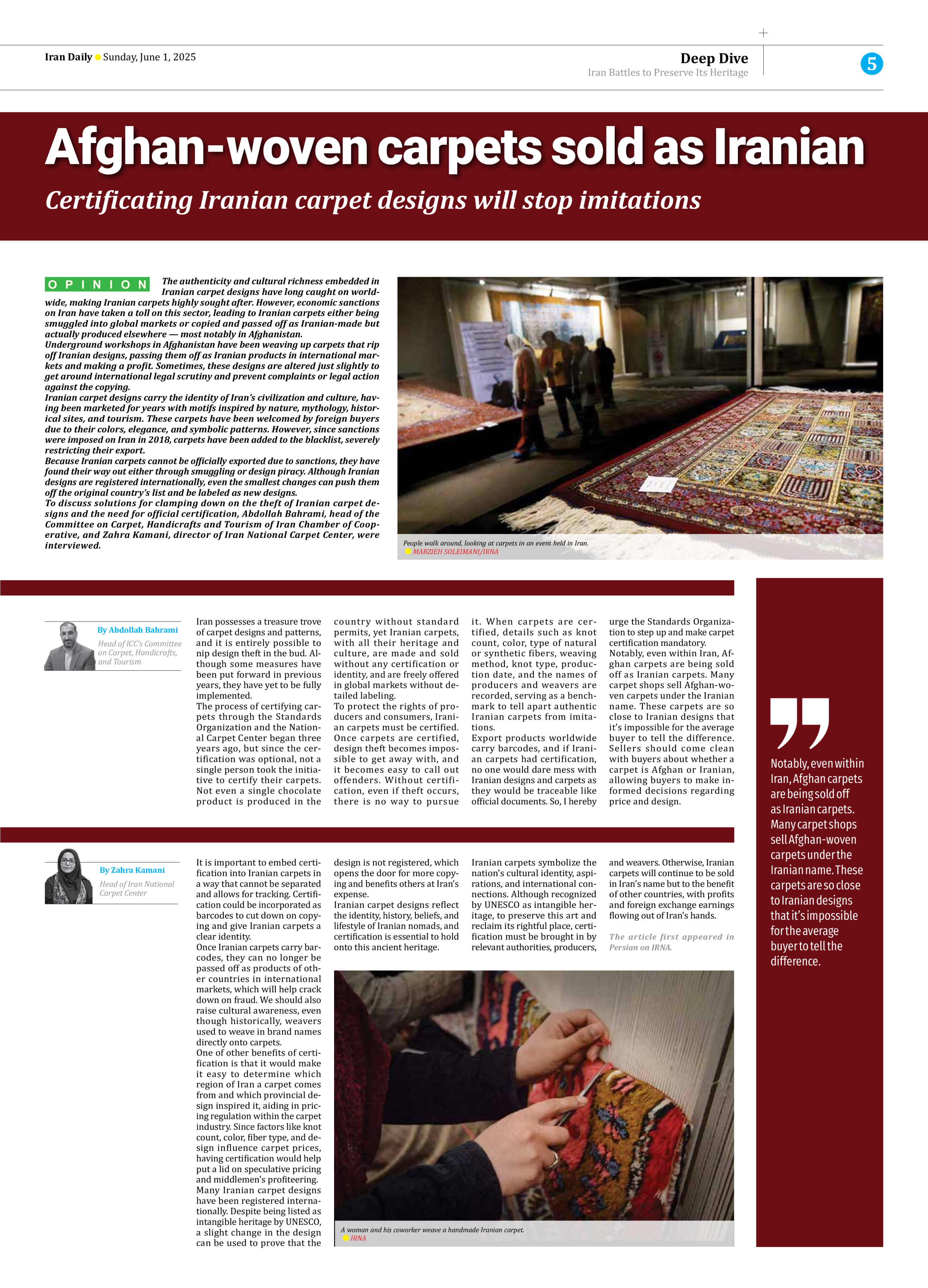
Afghan-woven carpets sold as Iranian
Certificating Iranian carpet designs will stop imitations
The authenticity and cultural richness embedded in Iranian carpet designs have long caught on worldwide, making Iranian carpets highly sought after. However, economic sanctions on Iran have taken a toll on this sector, leading to Iranian carpets either being smuggled into global markets or copied and passed off as Iranian-made but actually produced elsewhere — most notably in Afghanistan. Underground workshops in Afghanistan have been weaving up carpets that rip off Iranian designs, passing them off as Iranian products in international markets and making a profit. Sometimes, these designs are altered just slightly to get around international legal scrutiny and prevent complaints or legal action against the copying. Iranian carpet designs carry the identity of Iran’s civilization and culture, having been marketed for years with motifs inspired by nature, mythology, historical sites, and tourism. These carpets have been welcomed by foreign buyers due to their colors, elegance, and symbolic patterns. However, since sanctions were imposed on Iran in 2018, carpets have been added to the blacklist, severely restricting their export. Because Iranian carpets cannot be officially exported due to sanctions, they have found their way out either through smuggling or design piracy. Although Iranian designs are registered internationally, even the smallest changes can push them off the original country’s list and be labeled as new designs. To discuss solutions for clamping down on the theft of Iranian carpet designs and the need for official certification, Abdollah Bahrami, head of the Committee on Carpet, Handicrafts and Tourism of Iran Chamber of Cooperative, and Zahra Kamani, director of Iran National Carpet Center, were interviewed.
By Abdollah Bahrami
Head of ICC’s Committee on Carpet, Handicrafts, and Tourism
Iran possesses a treasure trove of carpet designs and patterns, and it is entirely possible to nip design theft in the bud. Although some measures have been put forward in previous years, they have yet to be fully implemented.
The process of certifying carpets through the Standards Organization and the National Carpet Center began three years ago, but since the certification was optional, not a single person took the initiative to certify their carpets. Not even a single chocolate product is produced in the country without standard permits, yet Iranian carpets, with all their heritage and culture, are made and sold without any certification or identity, and are freely offered in global markets without detailed labeling.
To protect the rights of producers and consumers, Iranian carpets must be certified. Once carpets are certified, design theft becomes impossible to get away with, and it becomes easy to call out offenders. Without certification, even if theft occurs, there is no way to pursue it. When carpets are certified, details such as knot count, color, type of natural or synthetic fibers, weaving method, knot type, production date, and the names of producers and weavers are recorded, serving as a benchmark to tell apart authentic Iranian carpets from imitations.
Export products worldwide carry barcodes, and if Iranian carpets had certification, no one would dare mess with Iranian designs and carpets as they would be traceable like official documents. So, I hereby urge the Standards Organization to step up and make carpet certification mandatory.
Notably, even within Iran, Afghan carpets are being sold off as Iranian carpets. Many carpet shops sell Afghan-woven carpets under the Iranian name. These carpets are so close to Iranian designs that it’s impossible for the average buyer to tell the difference. Sellers should come clean with buyers about whether a carpet is Afghan or Iranian, allowing buyers to make informed decisions regarding price and design.
By Zahra Kamani
Head of Iran National Carpet Center
It is important to embed certification into Iranian carpets in a way that cannot be separated and allows for tracking. Certification could be incorporated as barcodes to cut down on copying and give Iranian carpets a clear identity.
Once Iranian carpets carry barcodes, they can no longer be passed off as products of other countries in international markets, which will help crack down on fraud. We should also raise cultural awareness, even though historically, weavers used to weave in brand names directly onto carpets.
One of other benefits of certification is that it would make it easy to determine which region of Iran a carpet comes from and which provincial design inspired it, aiding in pricing regulation within the carpet industry. Since factors like knot count, color, fiber type, and design influence carpet prices, having certification would help put a lid on speculative pricing and middlemen’s profiteering.
Many Iranian carpet designs have been registered internationally. Despite being listed as intangible heritage by UNESCO, a slight change in the design can be used to prove that the design is not registered, which opens the door for more copying and benefits others at Iran’s expense.
Iranian carpet designs reflect the identity, history, beliefs, and lifestyle of Iranian nomads, and certification is essential to hold onto this ancient heritage.
Iranian carpets symbolize the nation’s cultural identity, aspirations, and international connections. Although recognized by UNESCO as intangible heritage, to preserve this art and reclaim its rightful place, certification must be brought in by relevant authorities, producers, and weavers. Otherwise, Iranian carpets will continue to be sold in Iran’s name but to the benefit of other countries, with profits and foreign exchange earnings flowing out of Iran’s hands.
The article first appeared in
Persian on IRNA.







